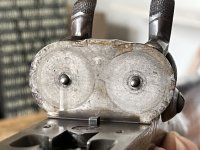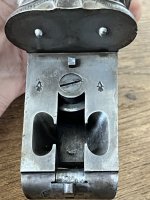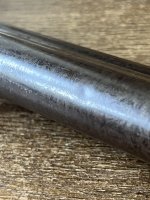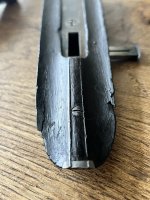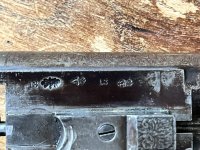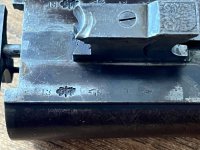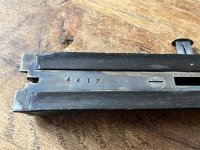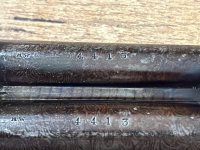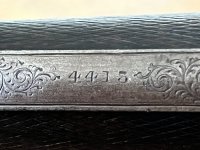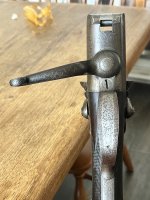There is definitely some interesting history with this gun. I would like to see more pictures, especially of the locks and the action bar. Proof marks of that period were pretty sparse, and don't tell much.
OK. The barrels started life on a pin-fire, we can presume for now one of John Blanch & Son's guns. The engraved lightning bolts on the top of the barrels at the breech are a good give-away, but look closely, and you will see iron squares inletted into the barrels where the pin-fire holes were. When the conversion was done and the barrels re-browned, it would have been invisible. Perhaps this angle makes it more visible:

The action itself appears to have been built as a centre-fire, and does not show obvious signs of conversion (though in the picture, I can almost see seams where additional metal might have been braised on the fences, before sculpting - more pictures needed). The cuts on the action bar to reduce weight are pretty characteristic of the work of Edwin C. Hodges, one of the best actioners of the period, and one who is known to have actioned guns for Blanch. So, quality all around. I'm assuming until told otherwise that Blanch's name is on the locks, which would suggest that someone, perhaps with a prized Blanch pin-fire, went back to the maker and asked for his barrels to be installed on a new central-fire gun (which may have re-used the locks from the pin-fire. "No problem," Blanch would have said, "Of course we can do that." Whatever the client wanted, he got. This is a gun that came from a skilled workman's bench, not a factory.
I can't quite make out if the action is a single-bite or a double-bite, which would help date the gun, further pictures of the action or barrel lumps would tell. There may also be what might look like random initials under the barrels, near the proofs. Being a Blanch gun, there may be the initials TP or JP, from the Portlock family of barrel makers, highly sought after. The action bar may carry the mark of the actioner as well, so any additional information on marks would be helpful.
Why would someone wish to have pin-fire barrels rebuilt into another gun? In the Victorian period, barrels were everything. Barrels which "shot hard" were treasured. They will be cylinder bore, as choke was yet to be invented, but the shooting qualities of a gun meant many were reluctant to part with them, even for the sake of moving to a new-fangled system like central-fire.
There is the slight possibility that the gun was re-built by another maker, especially if the locks carry another's name (or no name). Some gunmakers specialized in conversion work, usually saving as much as possible (barrels, locks, some furniture and sometimes the butt stock), but sometimes building a whole new gun around an old set of barrels (making conversions hard to spot).
Sadly a dented damascus barrel does not make for a shooter, even with black powder. This makes for a gun to be admired and talked about, but not taken to the field. While a shooter of damascus barrels myself, I would run away from any damascus-barrelled gun that looked like it had raised dents, so fixing it is really out of the question. In Canada, being a wall-hanger cuts the value quite a bit. To a collector of early central-fire guns, there is a limited demand, if you can find such a person. If the action turns out to have been re-worked from a pin-fire, someone like myself might be interested, no surprise there. Most wall-hangers are cheap guns, and sell cheaply. A high-quality wall-hanger is very difficult to price, because you have to find the person who really wants it just to admire it. It can be worth a few hundred bucks, and some patent actions can bring the price much higher -- but yours is not one of those. Unfortunately in Canada, quality and rarity aren't always part of the value calculation, and you have to be ready to wait for the right person to come along, who is ready to pay above the going rate for wall-hangers.
For those who might be interested, the firm of John Blanch and Son was one of the earliest proponents of the pin-fire system in Britain. With his son William, John built forward-underlever breech-loaders of the Lang type starting in 1856. Soon after, they may have been the first London gunmakers to market sporting guns with rearward-facing under-levers, a configuration better known as the lever-over-guard. The firm was at 29 Gracechurch Street, an address it occupied from 1826 to 1914. John Blanch had his residence in the fashionable Mayfair district. However, the 1861 census listed William still living at the Gracechurch Street address with his wife and three children; in most instances, a gunmaker's address appearing on the top rib of a gun was usually their home as well as their workshop. Blanch employed four men and one boy (apprentice) at the time, a reasonably typical operation for a successful gunmaker. In this modern age of factory production, it is worth remembering that back then, sporting gun makers were tiny operations, producing small numbers of guns to a limited and predominantly wealthy clientele. Sadly, the Luftwaffe erased all of Blanch's records.
I have Blanch gun no. 4696, a 12-bore pin-fire, which was probably made around 1864. Knowing what number is on your gun would also be helpful, as close to this would help date the gun.
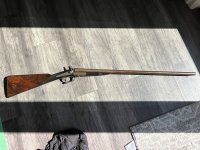 IMG_0146.jpeg161.7 KB · Views: 45
IMG_0146.jpeg161.7 KB · Views: 45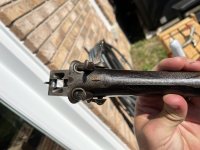 IMG_0135.jpeg97 KB · Views: 45
IMG_0135.jpeg97 KB · Views: 45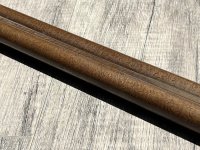 IMG_0137.jpeg185.9 KB · Views: 44
IMG_0137.jpeg185.9 KB · Views: 44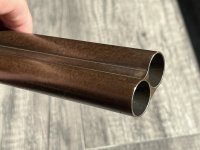 IMG_0138.jpeg86.2 KB · Views: 38
IMG_0138.jpeg86.2 KB · Views: 38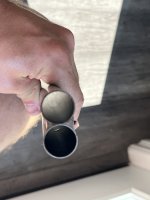 IMG_0140.jpeg65.8 KB · Views: 38
IMG_0140.jpeg65.8 KB · Views: 38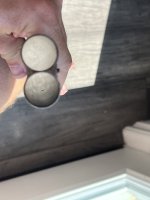 IMG_0141.jpeg60.1 KB · Views: 38
IMG_0141.jpeg60.1 KB · Views: 38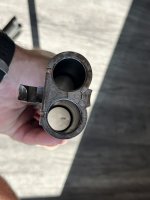 IMG_0143.jpeg66.7 KB · Views: 38
IMG_0143.jpeg66.7 KB · Views: 38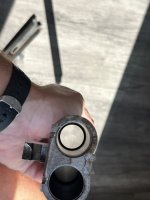 IMG_0142.jpeg72 KB · Views: 40
IMG_0142.jpeg72 KB · Views: 40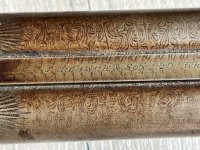 IMG_0144.jpeg196.2 KB · Views: 44
IMG_0144.jpeg196.2 KB · Views: 44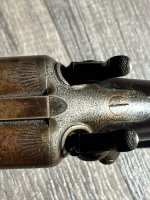 IMG_0150.jpeg151.4 KB · Views: 46
IMG_0150.jpeg151.4 KB · Views: 46
















































